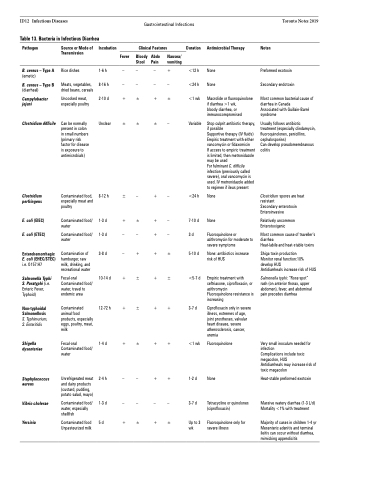Page 612 - TNFlipTest
P. 612
ID12 Infectious Diseases
Table 13. Bacteria in Infectious Diarrhea
Gastrointestinal Infections
Toronto Notes 2019
Pathogen
B. cereus – Type A (emetic)
B. cereus – Type B (diarrheal)
Campylobacter jejuni
Clostridium difficile
Source or Mode of Transmission
Rice dishes
Meats, vegetables, dried beans, cereals
Uncooked meat, especially poultry
Can be normally present in colon in small numbers (primary risk factor for disease is exposure to antimicrobials)
Contaminated food, especially meat and poultry
Contaminated food/ water
Contaminated food/ water
Contamination of hamburger, raw milk, drinking, and recreational water
Fecal-oral Contaminated food/ water, travel to endemic area
Contaminated animal food products, especially eggs, poultry, meat, milk
Fecal-oral Contaminated food/ water
Unrefrigerated meat and dairy products (custard, pudding, potato salad, mayo)
Contaminated food/ water, especially shellfish
Contaminated food Unpasteurized milk
Incubation
1-6 h 8-16 h 2-10 d
Unclear
Clinical Features
Fever Bloody Abdo Nausea/ Stool Pain vomiting
Duration
<12 h <24 h <1 wk
Variable
Antimicrobial Therapy
None None
Macrolide or fluoroquinolone if diarrhea >1 wk,
bloody diarrhea, or immunocompromised
Stop culprit antibiotic therapy, if possible
Supportive therapy (IV fluids) Empiric treatment with either vancomycin or fidaxomicin
If access to empiric treatment is limited, then metronidazole may be used
For fulminant C. difficile infection (previously called severe), oral vancomycin is used. IV metronidazole added to regimen if ileus present
None
None
Fluoroquinolone or azithromycin for moderate to severe symptoms
None: antibiotics increase risk of HUS
Empiric treatment with ceftriaxone, ciprofloxacin, or azithromycin Fluoroquinolone resistance is increasing
Ciprofloxacin only in severe illness, extremes of age, joint prostheses, valvular heart disease, severe atherosclerosis, cancer, uremia
Fluoroquinolone
None
Tetracycline or quinolones (ciprofloxacin)
Fluoroquinolone only for severe illness
Notes
Preformed exotoxin Secondary endotoxin
Most common bacterial cause of diarrhea in Canada
Associated with Guillain-Barré syndrome
Usually follows antibiotic treatment (especially clindamycin, fluoroquinolones, penicillins, cephalosporins)
Can develop pseudomembranous colitis
Clostridium spores are heat resistant
Secondary enterotoxin Enteroinvasive
Relatively uncommon Enterotoxigenic
Most common cause of traveller’s diarrhea
Heat-labile and heat-stable toxins
Shiga toxin production
Monitor renal function:10% develop HUS
Antidiarrheals increase risk of HUS
Salmonella typhi: “Rose spot” rash (on anterior thorax, upper abdomen), fever, and abdominal pain precedes diarrhea
Very small inoculum needed for infection
Complications include toxic megacolon, HUS
Antidiarrheals may increase risk of toxic megacolon
Heat-stable preformed exotoxin
Massive watery diarrhea (1-3 L/d) Mortality <1% with treatment
Majority of cases in children 1-4 yr Mesenteric adenitis and terminal ileitis can occur without diarrhea, mimicking appendicitis
Clostridium perfringens
E. coli (EIEC) E. coli (ETEC)
Enterohemorrhagic E. coli (EHEC/STEC) i.e. O157:H7
Salmonella Typhi S. Paratyphi (i.e. Enteric Fever, Typhoid)
Non-typhoidal Salmonellosis S. Typhimurium, S. Enteritidis
Shigella dysenteriae
Staphylococcus aureus
Vibrio cholerae Yersinia
8-12 h
1-3 d 1-3 d
3-8 d
10-14 d
12-72 h
1-4 d
2-4 h
1-3 d 5d
± –
+ ± – –
– +
+ ±
+ ±
+ ±
– –
– – + ±
+ –
+ – + –
+ ±
+ ±
+ +
+ +
+ +
– – + ±
<24 h
7-10 d 3d
5-10 d
<5-7 d
3-7 d
<1 wk
1-2 d
3-7 d
Up to 3 wk
– – – – + ±
± ±
– + – – + ±
± –


